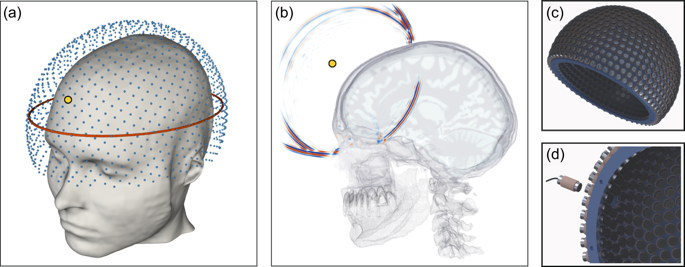npj Digital Medicine ( IF 12.4 ) Pub Date : 2020-03-06 , DOI: 10.1038/s41746-020-0240-8 Lluís Guasch 1 , Oscar Calderón Agudo 1 , Meng-Xing Tang 2 , Parashkev Nachev 3 , Michael Warner 1

|
Magnetic resonance imaging and X-ray computed tomography provide the two principal methods available for imaging the brain at high spatial resolution, but these methods are not easily portable and cannot be applied safely to all patients. Ultrasound imaging is portable and universally safe, but existing modalities cannot image usefully inside the adult human skull. We use in silico simulations to demonstrate that full-waveform inversion, a computational technique originally developed in geophysics, is able to generate accurate three-dimensional images of the brain with sub-millimetre resolution. This approach overcomes the familiar problems of conventional ultrasound neuroimaging by using the following: transcranial ultrasound that is not obscured by strong reflections from the skull, low frequencies that are readily transmitted with good signal-to-noise ratio, an accurate wave equation that properly accounts for the physics of wave propagation, and adaptive waveform inversion that is able to create an accurate model of the skull that then compensates properly for wavefront distortion. Laboratory ultrasound data, using ex vivo human skulls and in vivo transcranial signals, demonstrate that our computational experiments mimic the penetration and signal-to-noise ratios expected in clinical applications. This form of non-invasive neuroimaging has the potential for the rapid diagnosis of stroke and head trauma, and for the provision of routine monitoring of a wide range of neurological conditions.
中文翻译:

人脑全波形反演成像
磁共振成像和 X 射线计算机断层扫描提供了两种可用于以高空间分辨率对大脑进行成像的主要方法,但这些方法不易携带,并且不能安全地应用于所有患者。超声成像是便携式且普遍安全的,但现有的方式无法在成人头骨内部进行有效成像。我们使用计算机模拟来证明全波形反演(一种最初在地球物理学中开发的计算技术)能够生成具有亚毫米分辨率的精确大脑三维图像。这种方法通过使用以下内容克服了传统超声神经成像的常见问题:不会被头骨强烈反射遮挡的经颅超声、易于以良好信噪比传输的低频、正确考虑的精确波动方程用于波传播物理学和自适应波形反演,能够创建精确的头骨模型,然后适当补偿波前畸变。使用离体人类头骨和体内经颅信号的实验室超声数据表明,我们的计算实验模拟了临床应用中预期的穿透力和信噪比。这种形式的非侵入性神经影像有可能快速诊断中风和头部外伤,并提供对各种神经系统疾病的常规监测。









































 京公网安备 11010802027423号
京公网安备 11010802027423号